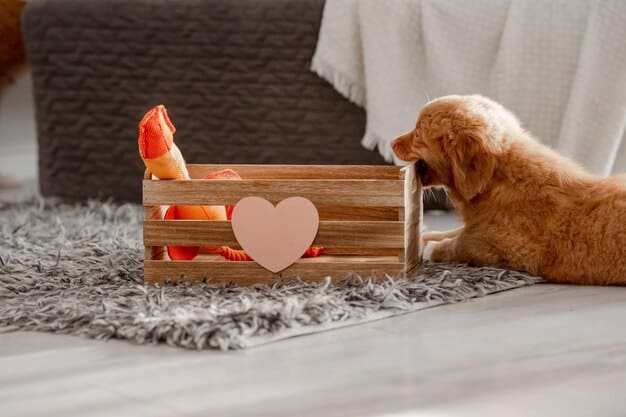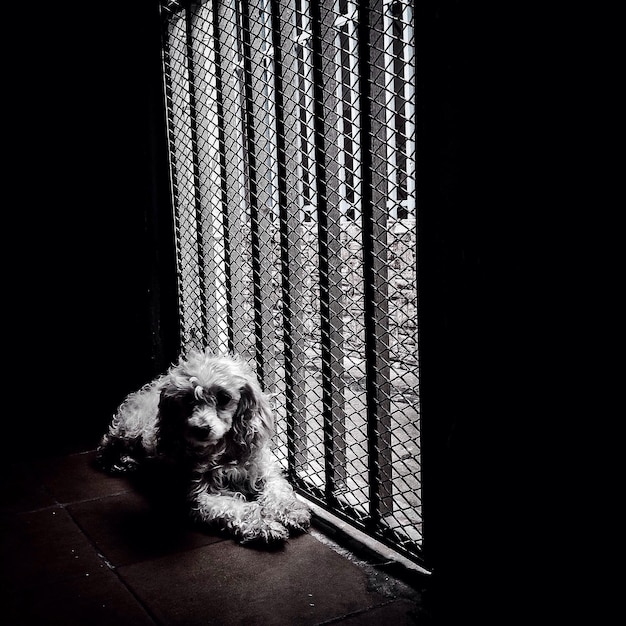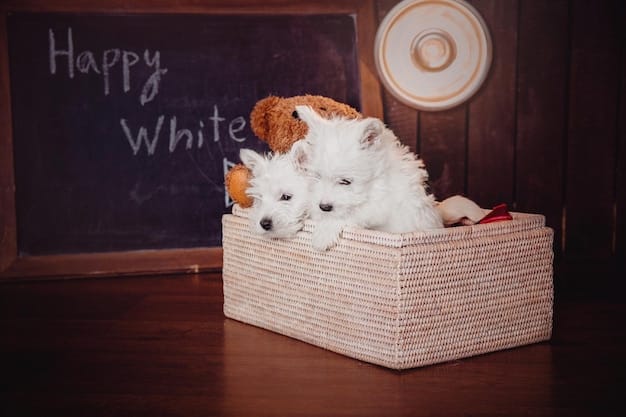Crate Training Anxious Dogs: A Humane, Tear-Free Guide

Crate training anxious dogs can be a positive experience when approached with patience, positive reinforcement, and an understanding of the dog’s emotional needs, transforming the crate into a safe and comforting retreat rather than a source of stress.
Is your anxious dog struggling with crate training? Crate training without the tears: a humane approach for anxious dogs is possible, by understanding your dog’s anxiety and creating a positive, safe space they’ll willingly enter.
Understanding Anxiety in Dogs and Crate Training
Before embarking on crate training, it’s crucial to understand that anxiety in dogs manifests differently and can significantly impact their ability to adjust to confinement. Understanding the root causes and symptoms of anxiety will help you tailor the crate training process, making it a positive experience for your furry friend.
Common Causes of Anxiety in Dogs
Anxiety in dogs can stem from various factors, including separation anxiety, fear of loud noises, past trauma, or even genetic predispositions. Identifying the cause is the first step in addressing the issue.
- Separation Anxiety: This occurs when a dog becomes distressed when left alone or separated from their owners.
- Noise Phobias: Loud noises like thunderstorms or fireworks can trigger intense fear and anxiety.
- Past Trauma: Negative experiences, such as being abandoned or abused, can lead to long-term anxiety issues.
- Medical Conditions: Sometimes, anxiety can be related to underlying health problems. Consulting with your veterinarian is essential to rule out any medical causes.
Ignoring the underlying causes of your dog’s anxiety and rushing the crate training process can intensify their fear and make the overall experience traumatic.

Recognizing the Signs of Anxiety
Recognizing the signs of anxiety is vital in adjusting your crate training approach. Anxious dogs exhibit a range of symptoms that may indicate their distress. Common signs include:
- Panting and Pacing: Excessive panting and restlessness.
- Whining and Barking: Vocalizations indicating distress.
- Trembling: Shaking or trembling, even in warm environments.
- Destructive Behavior: Chewing or scratching at the crate or surrounding areas.
With dogs that are already anxious, it’s important to recognize symptoms and signs of the anxiety before beginning crate training.
In conclusion, understanding the root causes of anxiety and recognizing the signs are critical steps in preparing for crate training. A tailored approach that considers your dog’s emotional needs is key to making the experience positive and tear-free.
Creating a Positive Crate Environment
The key to successful **crate training without the tears: a humane approach for anxious dogs** is to transform the crate from a potential source of anxiety into a haven. This involves making the crate as comfortable and inviting as possible, focusing on positive associations rather than forced confinement.
Choosing the Right Crate
The size and type of crate can significantly impact your dog’s perception of it. A crate that’s too small can feel claustrophobic, while one that’s too large might not provide the secure den-like feeling they need.
- Size Matters: The crate should be large enough for your dog to stand up, turn around, and lie down comfortably.
- Crate Type: Consider your dog’s personality. Some dogs prefer wire crates that offer visibility, while others feel securer in enclosed plastic ones.
- Location: Place the crate in a frequently used area of your home, like the living room or bedroom, so your dog doesn’t feel isolated.
A good tip is to measure your dog while they are sitting or standing at their full height to ensure that the crate is the right size.
Making the Crate Comfortable
A comfortable crate is essential in making your dog feel safe and secure. Soft bedding, familiar scents, and favorite toys can all contribute to a positive crate experience.
- Soft Bedding: Use a cozy bed or blanket that’s easy to clean and provides good support.
- Familiar Scents: Include items that smell like you, such as an old t-shirt, to provide comfort and security.
- Favorite Toys: Place a few of your dog’s favorite toys inside the crate to make it a fun place to be.
Introduce the crate slowly; allow your dog to explore it at their own pace. Toss treats or toys inside to encourage them to enter without force.

Transforming the crate into a positive space involves more than just providing physical comforts. It’s about creating an environment where your dog feels safe, secure, and relaxed. By carefully choosing the right crate, making it comfortable, and using positive reinforcement, you can help your anxious dog view the crate as their own personal retreat.
Introducing the Crate Gradually
The introduction to the crate should be a gradual process, especially for anxious dogs. Rushing the process or forcing your dog into the crate can lead to negative associations and increased anxiety. Patience and positive reinforcement are key.
The Treat and Toy Method
Using treats and toys is an excellent way to create positive associations with the crate. The goal is to make your dog feel excited and happy about entering the crate on their own.
- Initial Introduction: Leave the crate door open and toss treats inside, encouraging your dog to enter and explore.
- Positive Reinforcement: When your dog enters the crate, praise them and offer a high-value treat.
- Playtime in the Crate: Engage in playtime near or inside the crate, using toys to create a fun experience.
Feeding Meals in the Crate
Feeding your dog their meals inside the crate can help them associate the crate with positive experiences related to food. This method is particularly effective because it uses one of your dog’s favorite activities to change their perception of the crate.
- Start with the Door Open: Place the food bowl inside the crate with the door open, allowing your dog to eat comfortably without feeling trapped.
- Gradually Close the Door: As your dog becomes more comfortable, start closing the door briefly while they eat, gradually increasing the duration.
- Positive Reinforcement: Praise your dog and offer a treat after they finish their meal in the crate.
Introducing your dog to the crate gradually, using treats, toys, and feeding meals inside, can transform their perception of the crate from a potential source of anxiety to a positive and welcoming space. Remember to be patient and consistent, and always use positive reinforcement to ensure a tear-free experience.
Dealing with Crate Training Resistance
Even with the best preparation, some dogs may still resist crate training. It’s important to recognize their resistance and address it with patience and understanding. Do not resort to punishment or force; instead, focus on making the crate a positive and safe place.
Addressing Whining and Barking
Whining and barking are common signs of resistance during crate training. It’s crucial to differentiate between attention-seeking behavior and genuine distress. Ignoring attention-seeking whining while addressing signs of distress will make a big difference.
Managing Anxiety During Crate Time
If your dog exhibits signs of anxiety, such as panting, pacing, or destructive behavior, it’s important to take a step back and reassess your approach. Modifying your approach and taking the crate training slower can help. Consider consulting with a professional trainer or behaviorist for guidance.
- Calming Aids: Use calming aids, such as pheromone diffusers or calming treats, to help reduce your dog’s anxiety.
- Desensitization: Gradually expose your dog to the crate, starting with short periods and slowly increasing the duration as they become more comfortable.
- Comfort Items: Provide comfort items, such as a stuffed animal or blanket, to help your dog feel more secure.
Managing resistance demands a patient and adaptive strategy. Recognize the reasons for the opposition, whether it’s attention-seeking or real anxiety. Address the issue with empathy and positive ways. This strategy guarantees a less stressful and more effective crate training process for both you and your furry friend.
Extending Crate Time Gradually
Once your dog is comfortable entering the crate, the next step is to gradually increase the amount of time they spend inside. This should be done slowly and carefully to avoid triggering anxiety or resistance.
Increasing Duration Incrementally
Gradually increasing the duration of crate time is essential to ensure your dog remains comfortable and relaxed. Starting with short intervals and slowly extending the time can help them adjust to longer periods in the crate.
- Short Intervals: Begin with a few minutes at a time, gradually increasing the duration by a few minutes each day.
- Monitor Behavior: Pay close attention to your dog’s behavior and adjust the duration accordingly.
- Consistency: Be consistent with the timing to establish a routine.
Associating Crate Time with Relaxation
Creating a positive association between crate time and relaxation can help your dog feel more comfortable and secure. Encouraging your dog to relax in the crate with comforting activities makes a big impact.
- Calming Activities: Offer calming activities, such as chewing on a favorite toy or enjoying a puzzle feeder, to help your dog relax.
- Quiet Time: Use crate time as an opportunity for quiet time, away from distractions and excitement.
- Comforting Environment: Ensure the crate is comfortable and inviting, with soft bedding, familiar scents, and a quiet atmosphere.
Extending crate time requires patience, consistency, and a focus on positive reinforcement. By gradually increasing the duration and associating crate time with relaxation, you can help your anxious dog become more comfortable and secure in their crate.
Maintaining a Positive Association
Consistent effort is needed to maintain a positive association. Make sure the crate is always a welcoming and comforting place for your furry friend. Avoid using the crate as a punishment, as this will create negative associations and undo all your hard work.
Regular Reinforcement
Regular reinforcement of positive associations is crucial in maintaining your dog’s comfort and security in the crate. By continuing to use treats, toys, and praise, you can reinforce the positive feelings associated with the crate.
- Occasional Treats: Continue to offer occasional treats or toys inside the crate, even after your dog is fully crate trained.
- Verbal Praise: Praise your dog verbally when they enter the crate willingly.
- Positive Interactions: Engage in positive interactions near the crate, such as petting or talking to your dog while they are inside.
Avoiding Negative Experiences
Avoiding negative experiences associated with the crate is essential to prevent anxiety and resistance. Any perceived mistreatment of the crate can reverse all previous work. Ensure that the crate remains a safe and secure space for your dog.
- Never Use as Punishment: The crate should never be used as a place for punishment or time-out.
- Avoid Forcing Entry: Never force your dog into the crate or trap them inside against their will.
- Monitor Comfort: Pay attention to your dog’s body language and behavior, and adjust your approach if they show signs of distress.
In conclusion, maintaining a positive view of the crate involves staying consistent with positive reinforcement, staying clear of poor experiences, and continuously checking in on your dog’s comfort. This ensures that the crate lasts as a secure and happy haven for your dog.
| Key Point | Brief Description |
|---|---|
| 🐶 Understanding Anxiety | Recognize the causes and signs of anxiety in your dog before starting crate training. |
| 🛏️ Positive Environment | Make the crate comfortable with soft bedding, familiar scents, and favorite toys. |
| 🐾 Gradual Introduction | Introduce the crate slowly using treats, toys, and feeding meals inside. |
| ⏰ Gradual Crate Time | Increase crate time incrementally and associate it with relaxation. |
Frequently Asked Questions
▼
Signs of anxiety include panting, pacing, whining, barking, trembling, and destructive behavior. If your dog displays these symptoms around the crate, they may be anxious.
▼
Be patient and don’t force it. Make sure the crate is inviting with soft bedding and toys. Try smearing peanut butter inside to encourage them to investigate at their own pace.
▼
Adult dogs shouldn’t be crated for more than 4-5 hours during the day. Puppies need more frequent breaks. Never leave a dog crated all day long without a break.
▼
No, crate training is not cruel if done correctly. It provides dogs a secure space and can help with house training. The key is to introduce the crate positively and never use it for punishment.
▼
Yes, especially if you’re leaving your dog for more than a couple of hours. Use a spill-proof bowl to prevent messes. Always ensure fresh water is available.
Conclusion
In summary, **crate training without the tears: a humane approach for anxious dogs** is entirely achievable if approached with patience, understanding, and positive reinforcement. By recognizing the signs of anxiety, creating a comforting crate environment, introducing the crate gradually, and maintaining a positive association, you can help your dog view their crate as a safe and secure retreat.





